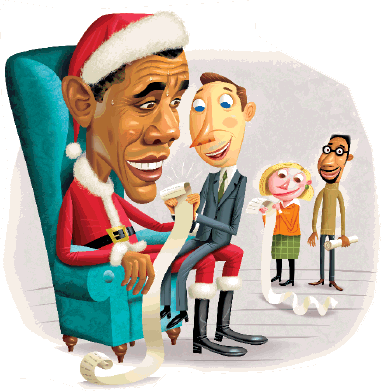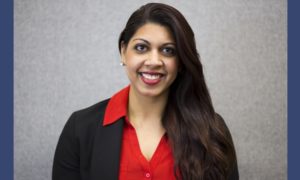After Barack Obama won last month’s presidential election, gatherings of youth workers and advocates took on the air of kids waiting for Santa to land at the mall.
Not only is the youth work field dominated by liberals, but many practitioners and leaders of various political stripes felt that the eight years of the Bush administration were the most miserable they could remember in terms of funding and policy.
So just two days after the vote, about 150 juvenile justice advocates packed a Georgetown Law School lecture hall in Washington to tell a panel of justice experts what they want from the new administration. When it was over after three hours, Shay Bilchik – the former head of the U.S. Office of Juvenile Justice and Delinquency Prevention and of the Child Welfare League of America (CWLA) – told the panel, “What has been suppressed is ready to be unleashed.”
Wish lists are flying at the Obama transition team – some through formal briefing documents (like CWLA and the Children’s Defense Fund), some letters and e-mails.
“It’s a time for optimism,” Obama adviser Charles Ogletree declared as he led the Nov. 6 juvenile justice panel hosted by the American Bar Association (ABA). At an Urban Institute (UI) forum a week later, “The Children’s Policy Agenda in a Time of Transition and Turmoil,” panelists advised the nearly 100 attendees about how to get the ear of Obama administration officials.
“I’m pumped, I am very pumped,” Jay Blitzman, a juvenile judge from Lowell, Mass., said at the ABA event.
Uh-oh.
Everyone cautions that the giddy anticipation must be tempered by the harsh fiscal realities facing the federal government and the nation. “If current trends continue, there will be fewer resources to make the kinds of investments that many of us believe in,” panelist Joan Huffer, a federal spending expert at the Center on Budget and Policy Priorities, said at the UI event, co-hosted by the University of Chicago’s Chapin Hall Center for Children.
And everyone has to cram into line with every other special interest in the country. “It’s just unimaginable how much information comes in,” said panelist Stephen Goldsmith, the former Indianapolis mayor who worked on the transition of President George W. Bush.
“Getting through all the noise” will be difficult, concurred Sheri Steisel, senior director of the Human Services Committee of the National Conference of State Legislatures.
At the ABA gathering, Ogletree advised: “Cost savings will be the key to selling your program.”
Goldsmith urged latching onto known priorities, like national service and job creation. For example: “Link kids to service,” because Obama pledged to expand national service programs, college graduates are enthusiastic about service, and much of that service is done at youth programs.
Youth Today gathered some of the formal policy briefings and invited informal contributions from throughout the field, from national associations to community-based agencies. Some are printed here. The complete responses appear here.
After-School
• Increase funding for after-school programs. We urge President-elect Barack Obama to increase funding to the full level authorized by No Child Left Behind – $2.5 billion.
• Reauthorize CLCs [Community Learning Centers] at a higher level. Congress has not yet renewed legislation authorizing funding for federal elementary and secondary education programs. When it does, we urge Obama to push for an increased authorization for afterschool programs.
• Leverage out-of-school-time learning to boost high school success. The alliance proposes that the federal government create a new initiative aimed at secondary school students that extends the learning day with after-school programs built around cooperation by all sectors of the community, including nonprofits, faith-based organizations, schools, businesses and institutions of higher education.
Jodi Grant, Executive Director
Afterschool Alliance
Washington
• It would be helpful if the Obama administration would understand that small community-based organizations need the same access to federal grant programs as public schools and major nonprofits such as the Y and Boys & Girls Club organizations. The stipulation of “collaboration” is a great one, but the interpretation at the local level usually eliminates the single-entity program.
Roz Mann
Children’s Learning Center
Malden, Mass.
• We need to increase music and dance education opportunities for all children and youth during the school day and after school. Every child should have the opportunity to learn how to play an instrument, how to dance and how to sing properly.
Susan Kenny, Executive Director
Roxbury Arts Group,
Roxbury, N.Y.
• Please put children and education on your priority list by doubling the amount of funds for the 21st Century Community Learning Centers Program. This investment will pay off in the future –guaranteed.
Michele Day,
Program Coordinator
21st CCLC, Lifelong learning Center
Frackville, Pa.
• I would like to see support for organizations that work with youth and young adults from 10 to 21 that have been given up on because of their criminal records, gang activity, drug problems and so forth. Early childhood education is extremely important, but what about those same kids when they reach 10? Please don’t forget about organizations that work with those youth and young adults that everyone has given up on.
Sierra Leone K. Samuels,
Executive Director
Circle of Discipline
Minneapolis
• I would request that reform efforts be interconnected, specifically that increases in science funding be tied with increases in youth funding, so that more young people can engage in the science and technology that increasingly defines their world. We need to change the national mindset about science as something that only happens in classrooms or labs.
Jason Freeman, Director
Coalition for Science After School
Berkeley, Calif.
• I’m looking for new forms of leadership and policy that create an infrastructure of ongoing and flexible support for youth-serving organizations, including volunteer-based tutor/mentor programs.
• I’d like government leaders to use maps to create an understanding of where the most disadvantaged youth are living, and to focus resources from public and private sector sources on the nonprofits already working in these areas, or on groups that will create new programs in areas with great need, but too few programs.
• I’d like the president to use his “bully pulpit” to give recognition and encouragement to donors, volunteers, churches, corporations and other elected leaders who are proactive in providing volunteers, dollars, technology and other needed resources to youth organizations – not just to brand-name organizations that only reach a few kids in a few parts of any city.
Daniel F. Bassill, President
Tutor/Mentor Connection
Chicago
• Youth-serving programs need consistent streams of funding – not that run out after five years like 21st Century Community Learning Center funding does in our state.
• Youth-serving programs need resources built in for professional development, like staff time, wages to cover staff time, money to hire quality trainers and technical assistants.
Katie Kaufmann, Project
Coordinator
St. Louis for Kids
Health
• Rescind the Bush administration’s August 2007 policy directive that limits states’ ability to provide health coverage to children in families above 250 percent of the federal poverty level.
Child Welfare League of America
Arlington, Va.
• Promote universal health care and lower health costs.
• Expand Medicaid and SCHIP.
• Promote healthy lifestyles.
Every Child Matters
Washington
• On day one, repeal Targeted Case Management and other Medicaid regulations that limit health care for vulnerable children and their families and impose massive financial burden on state governments.
• SCHIP renewal should be an immediate priority. The SCHIP bill needs to be at least $55 billion to cover the same number of children in the bill vetoed by the president (twice) last year. It should include options for states to cover immigrant children, extend coverage to older children, and provide more emphasis on primary, preventive and developmental health services.
• Expand funding for nutrition programs like food stamps, school breakfast, school lunch and the fruit and vegetable program, so no child has to go hungry.
David M. Laird,
Government Affairs and Policy
Voices for America’s Children
Washington
• Provide a temporary food stamp benefit increase in any economic stimulus package.
• Increase funding for, and improve access and nutrition in, the child nutrition programs, including the school meal programs, the Special Supplemental Nutrition Program for Women, Infants, and Children (WIC), child care food programs and out-of-school time nutrition.
Food Research and Action Center
Washington
Employment/Job Training
• Press for passage of the proposed Jobs for America’s Youth Act of 2008 to put 500,000 teens and youth 16 to 21 to work immediately, and another 1 million jobs this summer. Teen joblessness is at its post-world War II peak. The declines in early youth work experience will have very adverse consequences for their future employment and earnings.
Andrew Sum, Director
Center for Labor Market Studies,
Northeastern University
Boston
Juvenile Justice
• Federal funds for reducing juvenile crime should be treated as investments, not entitlements.
• The Department of Justice should stop using federal money to support routine provision and purchasing of services. Federal contributions for service provision will never amount to more than a drop in the ocean of juvenile justice spending by state and local governments. If properly targeted, OJJDP funds can stimulate innovation and build more effective juvenile justice systems.
Jeffrey A. Butts, Research Fellow
Chapin Hall Center on Children at the University of Chicago
• Sign a strong reauthorization of the Juvenile Justice and Delinquency Prevention Act that includes the recommendations of the National Juvenile Justice and Delinquency Prevention Coalition, including expanding the JJDPA’s jail removal and sight and sound core requirements to include youth no matter what court they are in – juvenile or adult.
• Oppose/veto any legislation that increases the number of youth prosecuted in or transferred to the state or federal adult criminal justice system.
• Collect detailed data on youth prosecuted in and transferred to state and federal adult systems, including the number of affected youth; how youth are prosecuted in and transferred to the adult system; where and how long youth are held pretrial and post-conviction; and the nature and length of post-release activities.
• Provide technical assistance and financial support to states to comply with current jail removal and sight and sound core requirements.
• Strengthen OJJDP by refocusing OJJDP on the JJDPA and its core protections for children; improving the provision of technical assistance to states; updating JJDPA regulations to reflect current priorities and core protections; restoring the comprehensive nature of the agency, including conducting research and gathering data, identifying and disseminating best practices and relevant information, leading demonstration projects, providing training and technical assistance, and promoting the expansion of effective practices in the field; and increasing transparency.
Campaign for Youth Justice
Washington
• Restore the following funding streams to at least their fiscal 2002 levels: Juvenile Accountability Block Grants ($250 million), Title II State Formula Grants ($89 million) and Title V Incentive Grants for Local Delinquency Prevention ($95 million).
• Support passage of the Youth PROMISE Act (Youth Prison Reduction through Opportunities, Mentoring, Intervention, Support and Education).
• Eliminate policies that allow termination of Medicaid, public housing or education alternatives after a youth is released from secure confinement.
National Juvenile Justice and Delinquency Prevention
Coalition
• Provide funds for the Juvenile Delinquency Model Court Project, which was funded to develop eight model sites but has not been funded to use those sites as national models.
National Council of Juvenile and Family Court Judges
Reno, Nev.
• Require independent audits of educational offerings in youth prisons.
• Require that vocational programs for girls offer the same courses as those offered for boys.
• Eliminate the Office of National Drug Control Policy’s youth media campaign and student drug-testing grants.
American Civil Liberties Union
New York
• Push for repeal of the Adam Walsh Act’s provision that youth who commit some sex offenses be placed on public registries, many for the rest of their lives.
National Juvenile Justice Network
Washington
• Develop programs at the Substance Abuse and Mental Health Services Administration that will help community-based health providers screen, assess and coordinate services for youth who have come into contact with the juvenile justice system.
National Council for Community Behavioral Healthcare
Washington
• Establish federal guidelines on the use of psychotropic medications to treat mental health disorders in children in the juvenile justice system.
• Increase the use of expert panels in the peer review process for OJJDP grant making.
American Psychological Association
Washington
• Increase resources for the Department of Justice Civil Rights Division to investigate and remedy conditions in juvenile facilities, and establish a priority at OJJDP to provide training and technical assistance for facilities that want to eliminate dangerous practices.
• Increase the role of the Department of Education in developing and promoting quality education inside juvenile facilities.
Center for Children’s Law and Policy
Washington
• Convene a congressional hearing on critical issues facing girls in the juvenile justice system.
• Create a designated funding appropriation exclusively for improving outcomes for girls in the juvenile justice system.
National Council on Crime and Delinquency, Center for Girls and Young Women
Jacksonville, Fla.
• Improve the quality and increase the frequency of bulletins and other documents from OJJDP.
• Improve monitoring of state compliance with the core requirements of the Juvenile Justice and Delinquency Prevention Act, and firmly enforce financial withholding penalties for states that are not in compliance.
The Sentencing Project
Washington
• Eliminate life without parole sentences for juveniles.
Human Rights Watch
New York
Child Welfare
• Enact legislation to fund home visitation programs and provide targeted funds that encourage the development of successful evidenced-based neighborhood programs.
• Reauthorize and increase funding to the Adoption Opportunities program, with a greater emphasis on post-adoption services and the recruitment of minority parents.
• Extend Medicaid coverage to all youth formerly in foster care until at least age 21, and establish therapeutic foster care as a Medicaid reimbursable service.
• Increase funding significantly for the Chafee Foster Care Independence Program.
• Allow the use of Title IV-E training funds for training in activities designed to keep children out of foster care.
• Create a model similar to Teach for America that would recruit college graduates to serve in children’s human services for two years as a strategy to build the child welfare and other key human service work forces.
• Ensure immigration enforcement officials give sufficient notice to state child and human service agencies of impending raids.
Child Welfare League ofAmerica
Arlington, Va.
• To break free of the foster-care industrial complex you need a “child welfare cabinet,” informal advisors who’ve actually improved child welfare systems – which means it’s going to be a short list: people like James Beougher in Maine, Marc Cherna in Pittsburgh, John Mattingly in New York City, Jess McDonald in Illinois, Kevin Ryan in New Jersey, and Paul Vincent in Alabama.
• You can make huge improvements in child welfare simply by making the money you’ve got flexible. Offer states their current open-ended entitlement as a negotiated flat grant, increasing annually with inflation. States that curb the misuse and overuse of foster care could keep the savings; states with a take-the-child-and-run mentality would have to pay for the harm they do to children.
• When states won’t accept flat grants, reimburse less for placements in group homes than for families and less for institutions than for group homes.
• Don’t give in on what the foster-care industrial complex calls “delinking.”
• Grandparents are tied up in knots having to comply with the same hypertechnical foster home licensing requirements applied to strangers. In at least one state, grandparents living in apartments like the one where you grew up in Hawaii couldn’t be licensed unless they had two exits. You can free grandparents from these restrictions.
Richard Wexler, Executive Director
National Coalition for Child
Protection Reform
Alexandria, Va.
• A guaranteed source of federal funding must be provided to: allow states to reinvest funds for proven, prevention-based practices; remove the byzantine financial eligibility criteria that guide state services for foster children; invest in a high-quality trained work force; and promote greater accountability within the child welfare system.
• Expand the adoption tax credit to include other permanency options.
David M. Laird
Government Affairs and Policy
Voices for America’s Children
Washington
Fatherhood
• We urge you to push for continued and increased funding of the Department of Health and Human Services’ Responsible Fatherhood Initiative, which is providing $50 million annually to support responsible fatherhood programs across the nation.
• We urge you to be a powerful voice in rebuilding a culture of responsible fatherhood in America. Through the power of your example as a devoted husband and father, and the power of your words as president, you can help renew the commitment of America’s fathers to be the kinds of dads their children need them to be.
Roland C. Warren, President
National Fatherhood Initiative
Gaithersburg, Md.
Education
• More money for support staff in public education, i.e., social workers.
• Money to help high school students who want to take dual credit classes – college credit along with high school credit.
Sandy Stevenson
Assistant Director
SchoolZOut
Fort Madison, Iowa
• We need to change what we as a nation believe is “education.” Those of us who work with youth know that their education exceeds the boundaries of the traditional classroom. We know what out-of-school experiences significantly and positively impact our youth.
• Funding should be used to support programs that bridge the gap between research and practice.
• Money should be spent on programs that support and supplement traditional learning environments while integrating problem-solving opportunities with civic engagement.
Cheryl Lynn Tatum
Educator/Advocacy Consultant
Recreation
• I would love to see strong support for amateur boxing, which is an extremely strong program for hard-to-reach youth and young adults.
Sierra Leone K. Samuels,
Exective Director
Circle of Discipline
Minneapolis

































